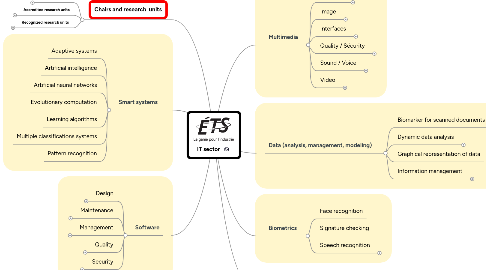
1. Chairs and research units
1.1. Research chairs
1.1.1. Chair in the Study of Adaptive and Evolutionary Monitoring Systems in Dynamic Environments
1.1.2. Chair on Shared Cloud Computing and Intelligent Applications
1.1.3. Vantrix Industrial Chair in Video Optimization
1.2. Accredited research units
1.2.1. LIVIA – Imaging, Vision and Artificial Intelligence Laboratory
1.3. Recognized research units
1.3.1. GELOG – Software Engineering Research Laboratory
1.3.2. LABMULTIMEDIA – Multimedia Research Laboratory
1.3.3. SYNCHROMÉDIA – Multimedia Communication in Telepresence
2. Smart systems
2.1. Adaptive systems
2.2. Artificial intelligence
2.3. Artificial neural networks
2.4. Evolutionary computation
2.5. Learning algorithms
2.6. Multiple classifications systems
2.7. Pattern recognition
3. Software
3.1. Design
3.1.1. Analysis of specifications and functional and non-functional requirements
3.1.2. Architecture and software design
3.1.3. Cloud computing
3.1.3.1. Hadoop
3.1.3.2. Management
3.1.3.3. Security
3.1.4. Green IT
3.1.4.1. Optimization of energy consumption in the cloud and virtualization environments
3.1.4.2. Quantification of reducing carbon emissions
3.1.4.3. Reducing carbon emissions through the use of cloud computing and virtualization
3.1.4.4. Sustainable devlopment Telco Cloud
3.1.5. Integration of non-communicating software
3.1.6. Internet of things
3.1.7. Middleware
3.1.8. Open software
3.1.9. Simulations
3.1.10. Virtualization
3.2. Maintenance
3.2.1. Management
3.3. Management
3.3.1. Assessment of migration cost
3.3.2. Benchmarking of softwares
3.3.3. Cost optimization of the software
3.3.4. Development and deployment of software
3.3.5. Environment for service creation
3.3.6. Evaluation of software solutions on the market
3.3.7. IT for education and learning
3.3.8. IT outsourcing
3.3.9. Project management
3.3.9.1. Audit
3.3.9.2. Estimation and management of software projects
3.3.9.3. Maturity models
3.3.9.4. Risk analysis
3.3.9.5. Software measures
3.4. Quality
3.4.1. Best practices in business
3.4.2. ISO standards (quality assessment of software product)
3.4.3. Modeling of IT applications in business
3.4.4. Optimizing the reliability of embedded systems
3.4.5. Quality assurance
3.4.6. Quality engineering for computer systems
3.4.7. Verification and validation (reducing faults)
3.5. Security
3.5.1. Cybercrime
3.5.2. Intrusion and malware detection in smartphones
3.5.3. Intrusion detection in computer networks
3.5.4. Mechanisms to enhance the security of embedded systems
3.5.5. Policies and IT Security
3.5.6. Security against malware for battery powered systems
3.5.7. Security for RFID technology
3.5.8. Security infrastructure of telecommunications networks
3.5.9. Security of cloud computing
3.5.10. Worms and viruses
4. Multimedia
4.1. Graphics
4.1.1. 3D animation
4.1.2. Fluid simulation for visual effects in the multimedia industry
4.1.3. Image synthesis and visualization
4.2. Image
4.2.1. Fields of application
4.2.1.1. Environmental sector
4.2.1.2. Health sector
4.2.1.3. Satellite images
4.2.2. Multiview
4.2.3. Real images
4.2.4. Real time
4.2.5. Transcoding
4.3. Interfaces
4.3.1. Ergonomy
4.3.2. Audiovisual indexing
4.3.3. Virtual reality
4.3.4. Visual representation of data
4.3.5. Telepresence
4.3.6. Computer Vision
4.3.7. Semantic Web
4.4. Quality / Sécurity
4.4.1. Increase IT security through analysis of data transferred over the Internet
4.4.2. Securing Internet content as well as its access
4.5. Sound / Voice
4.5.1. Emotion recognition
4.5.2. Sound adaptation (aid, assistance, measure)
4.5.3. Speaker recognition
4.5.4. Voice activity detection
4.6. Video
4.6.1. 3D TV
4.6.2. Correction and enhancement of video sequences
4.6.3. Objective measurement of visual quality
4.6.4. Parallel programming on GPU
4.6.5. Processing
4.6.5.1. Compression
4.6.5.2. Transcoding
4.6.6. Video security
5. Data (analysis, management, modeling)
5.1. Biomarker for scanned documents
5.2. Dynamic data analysis
5.2.1. Big data analysis
5.2.2. Classification, archiving, automatic identification
5.2.3. Data and text mining
5.2.4. Digital Image processing
5.2.5. Document analysis
5.2.6. Document interpretation
5.2.7. Recognition of cursive, handwriting wrinting and feature extraction
5.3. Graphical representation of data
5.4. Information management
5.4.1. Indexing data
5.4.2. Information architecture, ontology, semantic
5.4.3. Metadata
5.4.4. Reuse of product development information
5.4.5. Securing content and its access
5.4.6. Suppression of engineering drawings
6. Biometrics
6.1. Face recognition
6.2. Signature checking
6.3. Speech recognition
6.3.1. Active biometrics
6.3.2. Intra-auricular interface
6.3.3. Speaker recognition
7. Researchers and departments involved
7.1. Departments
7.1.1. Department of Automated Production
7.1.2. Department of Software and IT
7.2. Researchers
7.2.1. Number of researchers "Core": 18 (researchers who have this area as a central research theme)
7.2.2. Number of researchers "No Core": 11 (researchers who participate in research projects may be related to this topic)

